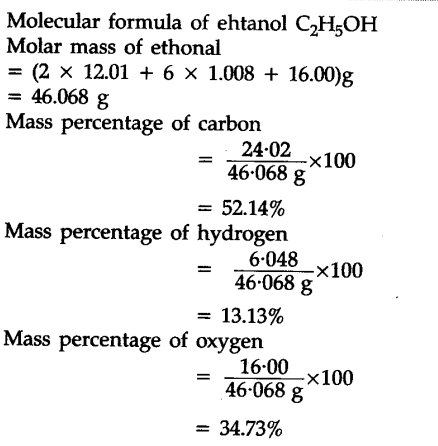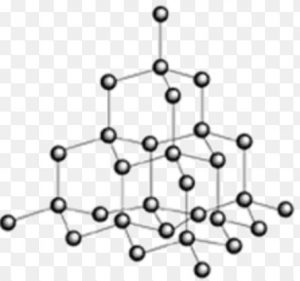Ask questions which are clear, concise and easy to understand.
Ask QuestionPosted by Madhur Kumar 4 years, 11 months ago
- 2 answers
Posted by Vaishnavi Yaduvanshi 5 years ago
- 0 answers
Posted by Arpit Pandey 5 years ago
- 1 answers
Yogita Ingle 5 years ago
What is mass percentage composition of each element present in ehanol
Answer:

Posted by Prabal Verma 5 years ago
- 1 answers
Posted by Arpit Pandey 5 years ago
- 1 answers
Arpit Pandey 5 years ago
Posted by Madhur Kumar 5 years ago
- 0 answers
Posted by Madhur Kumar 5 years ago
- 2 answers
Posted by Pooja Jain 5 years ago
- 1 answers
Yogita Ingle 5 years ago
Common physical features of alkali metals:
(1) They are soft and can be easily cut.
(2) They have silvery white appearance. They are light coloured.
(3) Due to large atomic size, they have low density. On moving down the group the density increases with exception of K which has lower density than Na.
(4) Due to weak metallic bonding, alkali metals have low melting and boiling points.
(5) They provide characterisitc colour to flames.
(6) They show photoelectric effect. On irradiation with lightCs and K lose electrons.
Common chemical features of alkali metals:
Due to low ionization enthalpy, akali metals have high reactivity.
On moving down the group, the reactivity increases.
(1) On reaction with water, oxides and hydroxides are formed.
On moving down the group, the reaction becomes more and more vigorous.
(2) On reaction with water, hydroxide and hydrogen are formed.
2M+2H2O→2MOH+H2
(3) On reaction with hydrogen, hydrides are formed.
2M+H2→MH
(4) They directly combine with halogens to form ionic halides. Li is an exception.
2M+Cl2→2MCl,(M=Li,K,Rb,Cs)
(5) They are strong reducing agents. On moving down the group, the reducing power increases with exception of Li. Due to high hydration energy, Li is the strongest reducing agent among alkali metals.
(6) They dissolve in liquid ammonia. The solution is deep blue in colour due to presence of ammoniated electrons.
Posted by Rohit Rohit 5 years ago
- 1 answers
Abirami Kamalbabu 4 years, 11 months ago
Posted by Aniket Dhiman 5 years ago
- 0 answers
Posted by First Name 5 years ago
- 3 answers
Yogita Ingle 5 years ago
Pyrolysis is defined as the conversion of a compound into smaller fragments in the absence of air through the application of heat. It is different from combustion. It happens in the absence of air and hence oxidation of compounds does not take place. Generally, pyrolysis of alkanes is also named as cracking.
Posted by Owais Khan 5 years ago
- 3 answers
Posted by Rohit Rai 5 years ago
- 1 answers
Yogita Ingle 5 years ago
Magnesium nitrate crystallizes with six molecules of water while barium nitrate crystallizes as the anhydrous salt. This again shows that the tendency to form hydrates decreases with increasing size and decreasing hydration enthalpy down the group.
Posted by Rohit Rai 5 years ago
- 2 answers
Posted by Madhur Kumar 5 years ago
- 2 answers
Gaur Saab?? 5 years ago
Posted by Rohit Rai 5 years ago
- 3 answers
Posted by Rohit Rai 5 years ago
- 1 answers
Yogita Ingle 5 years ago
The boiling point for Gallium stands at approximately 2200 degrees Celsius, and its density is 5.907 grams per cubic centimetre which is high like the density of water.
Posted by A Thelei 5 years ago
- 2 answers
Aadya Singh 5 years ago
Both O2 n O2+ is paramagnetic .
Posted by Madhur Kumar 5 years ago
- 1 answers
Gaurav Seth 5 years ago
Optical isomerism is basically a type of stereoisomerism. Now, before we learn about optical isomerism let us quickly recall what are isomers and stereoisomers. Isomers are those compounds which have the same molecular formula but different bonding arrangement among atoms.
Whereas, in stereoisomer, both molecular formula and bonding arrangement of atoms are the same. However, they have different spatial (three dimensional) arrangement of atoms. It eliminates all different arrangements that are simply due to the molecule spinning in its entirety or revolving around unique bonds.
Posted by Ekta Rajput 5 years ago
- 1 answers
Yogita Ingle 5 years ago
The higher the magnitude of lattice energy, the stronger the ionic bond formed. This is because more energy is released when strong bonds are formed.
Posted by Pk✍️ . 5 years ago
- 1 answers
Yogita Ingle 5 years ago
- Where one-colour merges into another and there is no definite boundaries, that spectra is called continuous spectra.
- If we study it for atoms the spectra obtained is discontinuous spectra.
- The study of spectra is called spectroscopy
Posted by Punam Ingale ?? 5 years ago
- 1 answers
Yogita Ingle 5 years ago
Some important applications of this branch of chemistry are listed below.
- The shelf lives of many medicines are determined with the help of analytical chemistry.
- It is used to check for the presence of adulterants in drugs.
- Soil can be tested to check for appropriate concentrations of minerals and nutrients that are necessary for plant growth.
- It is employed in the process of chromatography where the blood samples of a person are classified.
Posted by Sourav Singh 5 years ago
- 2 answers
Madhur Kumar 5 years ago
Gaurav Seth 5 years ago
Ans: Cs
Among alkali metals, melting point decreases as the strength of metallic bonding decreases with increasing size of the atom. Thus, Cs has the lowest melting point (28.5°C) and will melt at 30°C.
Posted by Akshat Anand 5 years ago
- 1 answers
Gaurav Seth 5 years ago
i.
ANSWER
The manufacture of ammonia by Haber's process is an exothermic reaction. According to Le Chatelier's principle maximum yield of an exothermic reaction can be obtained at low temperatures. There are 4 molecules on reactant side and 2 on product side. According to Le Chatelier's principle if you increase the pressure the system will respond by favouring the reaction which produces fewer molecules. So the maximum yield of ammonia will be obtained at high pressure and low temperature
Posted by Punam Ingale ?? 5 years ago
- 1 answers
Gaurav Seth 5 years ago
Chromatography: It is a technique used to separate mixtures in to their components, purify. Compounds which can be solid or liquid and also test the purity of compounds.
- In this technique the mixture of substances are applied on to a stationary phase .Then a pure solvent or a mixture of solvents is allowed to move slowly over stationary phase .The components of mixture gets gradually separated from one another .The moving phase is mobile phase .
The chromatography is classified into two categories:
- Adsorption chromatography
- Partition chromatography
Posted by ?Ritesh Gupta? 5 years ago
- 2 answers
Posted by Charanpreet Khaira 5 years ago
- 1 answers
Gaurav Seth 5 years ago
Diamond
It can also be prepared artificially but because of the high cost and poor quality, diamonds are seldom made artifically.
Structure

In diamond , carbon is sp3– hybridised . Each carbon is tetrahedrally linked to four neighbouring carbon atoms through four strong C-C , sp3– sp3 , σ bonds. This network extends in three dimensional and is very rigid.
Posted by ?Ritesh Gupta? 5 years ago
- 3 answers
Aayushi Chauhan 5 years ago

myCBSEguide
Trusted by 1 Crore+ Students

Test Generator
Create papers online. It's FREE.

CUET Mock Tests
75,000+ questions to practice only on myCBSEguide app
 myCBSEguide
myCBSEguide

Madhur Kumar 4 years, 11 months ago
0Thank You